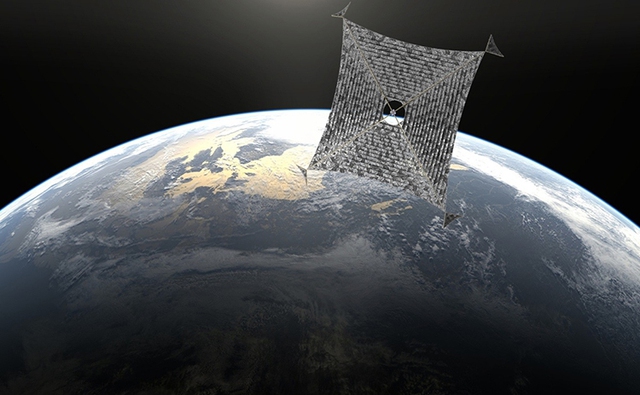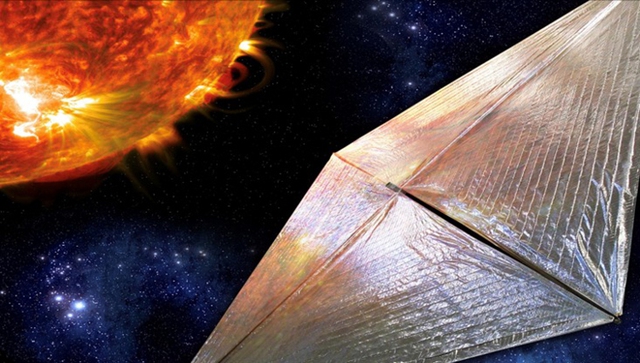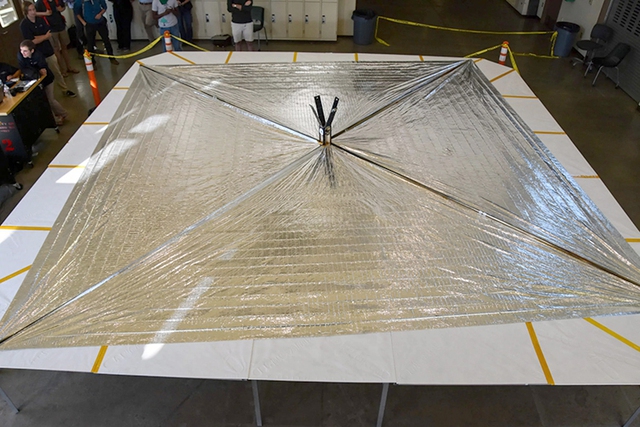‘Bending’ light to travel in space, what’s so special about this NASA solar sail?
The US space agency NASA has been conducting a research program called Innovative Advanced Concepts (NIAC). This is a research and development project of diffraction sail for 2 years with a cost of 2 million USD.
Once successful, the project will promote the application of high-tech solar sails to space spacecraft in the future.
New way to space travel
Similar to a conventional sail on a ship, which uses wind to create motion, a solar sail works by using the pressure created by sunlight to help a spacecraft move through space.
Light is made up of particles called photons. Photons do not have any mass, but they do have mass as they travel through space. When light hits a solar sail with a bright, mirror-like surface, their momentum is transferred to the sail, giving it a small amount of thrust.

Solar sails in space.
Besides, when bouncing off the sail, the photons create another small repulsion. Both thrusts are very light, but in zero gravity, each push will be enough to accelerate the sail.
When this mechanism works, the spacecraft will be able to move through space without using fuel.
The current refracting solar sail design is quite large, thin and often limited in direction of travel. However, a diffracted Solar sail with small squares on the thin film could make it more flexible and easier to steer.
How fast can a solar sail go?
The speed of a solar sail depends on its size and mass. A larger sail captures more sunlight, has more momentum, and accelerates faster for the same mass.
For a given sail size, a spacecraft with a lower mass will have a higher acceleration. Acceleration also depends on the spacecraft’s distance from the light source and the intensity of the light source.

The distance between the sail and the Sun also determines the speed of the spacecraft.
As a spacecraft using a solar sail gets further away from the Sun, the amount of light it has to spend decreases, which means slower speeds.
To give a concrete example of solar sail speed, LightSail 2’s 32 square meter sails accelerate to just 0.058 mm/s². During a month of continuous sunlight, the spacecraft’s speed will increase by a total of 549 km/h, roughly the same as the maximum speed of a jet.
Solar Sail Revolution
The most exciting thing about solar sails is that they can open up new avenues for space science and exploration. Solar sail-powered spacecraft can reach distant planets and star systems much faster than rocket-powered spacecraft.

A solar sail in progress.
In the near future, solar sails could also be effectively used for other types of tasks including monitoring the sun, continuous monitoring of the Earth’s polar regions or some space object.
Solar sails could also provide propulsion for CubeSats, small, inexpensive satellites that are increasingly being used by emerging astronaut nations, small companies and even school groups. This benefit expands the opportunity to explore space without depending on rocket fuel.
The concept of a diffracted solar sail was first selected for phases 1 and 2 of the NIAC in 2019. During those two phases and testing, a research team examined several materials for the construction of the wing. sails, and develop navigation and control for the Sun’s pole orbit.

Solar sails make it easier for small research units to reach than rocket fuel.
Both stages feature weather tests to test their ability to survive UV exposure. In phase 3, the researchers will optimize the fabrication materials and conduct ground testing in preparation for the mission to the Sun.
The Indian government launched missions powered by solar sails to support communications satellites in 1992 and 2003. The Japanese Space Exploration Agency (JAXA) successfully launched the new IKAROS-equipped spacecraft. Solar sails in 2010 to study Venus and the Sun. Since then, NASA and the non-profit research organization Planetary Society have both successfully launched spacecraft equipped with solar sails to low Earth orbit.
at Blogtuan.info – Source: cafebiz.vn – Read the original article here



